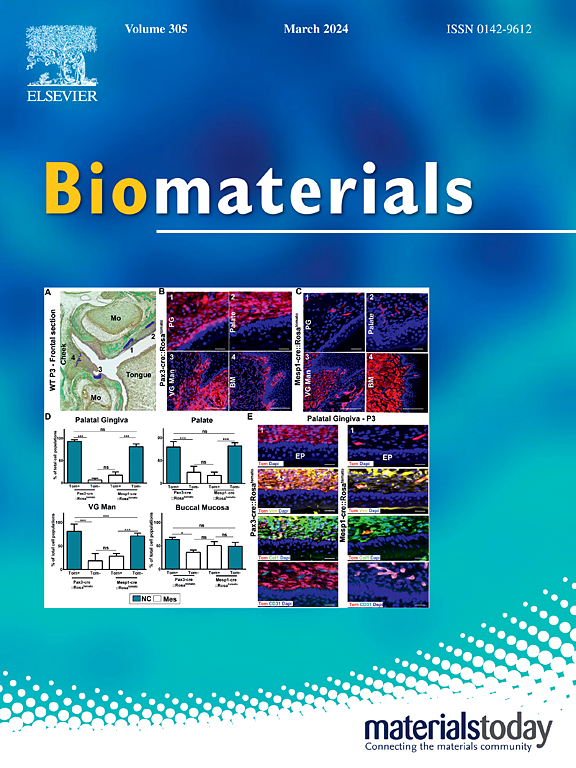Engineering long-lived charge separation states boosts type-I ROS generation for efficient cancer therapy
IF 12.8
1区 医学
Q1 ENGINEERING, BIOMEDICAL
引用次数: 0
Abstract
Organic photosensitizers (PSs) with long-lived charge-separated states (CSs) are optimal for converting photonic energy into reactive oxygen species (ROS) by maximizing the interaction between excited electrons and holes in subsequent photoreactions. However, the substantial consumption of oxygen by the singlet oxygen species produced by these PSs can significantly impede their anticancer efficacy, because of the hypoxia nature of solid tumors. Herein, we present a rational strategy for the structural modification of the well-known Fukuzumi acridinium salt (9-mesityl-10-methylacridinium ion) with long-lived CSs, by incorporating a methyl-substituted diphenylamine group (named MTPAA). This modification significantly enhances type-I ROS generation. The “methyl effect” in MTPAA has distinguished merits of stabilized radical species through resonance, leading to an over 8-fold increase in type-I ROS generation compared to TPAA, which lacks the methyl group. Moreover, cellular experiments show that MTPAA with the “methyl effect” significantly enhances photodynamic therapy efficacy under hypoxic conditions. Our molecular design strategy offers a promising approach to creating high-performance type-I PSs and is anticipated to inspire broader exploration in other photosensitizer systems with long-lived CSs, serving as a versatile strategy for advancing type-I PS development.

设计长寿命电荷分离态,促进 I 型 ROS 生成,实现高效癌症治疗
具有长寿命电荷分离态(CSs)的有机光敏剂(PSs)能在随后的光反应中最大限度地发挥激发电子和空穴之间的相互作用,是将光子能量转化为活性氧(ROS)的最佳光敏剂。然而,由于实体瘤的缺氧特性,这些 PSs 产生的单线态氧对氧气的大量消耗会严重影响它们的抗癌功效。在此,我们提出了一种合理的策略,通过加入甲基取代的二苯胺基团(命名为 MTPAA),对著名的 Fukuzumi 吖啶鎓盐(9-甲巯基-10-甲基吖啶鎓离子)与长寿命 CSs 进行结构修饰。这种修饰大大增强了 I 型 ROS 的生成。MTPAA 中的 "甲基效应 "具有通过共振稳定自由基物种的突出优点,与缺少甲基的 TPAA 相比,其产生的 I 型 ROS 增加了 8 倍以上。此外,细胞实验表明,在缺氧条件下,具有 "甲基效应 "的 MTPAA 能显著提高光动力疗法的疗效。我们的分子设计策略为创造高性能的 I 型 PS 提供了一种前景广阔的方法,预计将在其他具有长寿命 CS 的光敏剂系统中激发更广泛的探索,成为推动 I 型 PS 开发的一种多功能策略。
本文章由计算机程序翻译,如有差异,请以英文原文为准。
求助全文
约1分钟内获得全文
求助全文
来源期刊

Biomaterials
工程技术-材料科学:生物材料
CiteScore
26.00
自引率
2.90%
发文量
565
审稿时长
46 days
期刊介绍:
Biomaterials is an international journal covering the science and clinical application of biomaterials. A biomaterial is now defined as a substance that has been engineered to take a form which, alone or as part of a complex system, is used to direct, by control of interactions with components of living systems, the course of any therapeutic or diagnostic procedure. It is the aim of the journal to provide a peer-reviewed forum for the publication of original papers and authoritative review and opinion papers dealing with the most important issues facing the use of biomaterials in clinical practice. The scope of the journal covers the wide range of physical, biological and chemical sciences that underpin the design of biomaterials and the clinical disciplines in which they are used. These sciences include polymer synthesis and characterization, drug and gene vector design, the biology of the host response, immunology and toxicology and self assembly at the nanoscale. Clinical applications include the therapies of medical technology and regenerative medicine in all clinical disciplines, and diagnostic systems that reply on innovative contrast and sensing agents. The journal is relevant to areas such as cancer diagnosis and therapy, implantable devices, drug delivery systems, gene vectors, bionanotechnology and tissue engineering.
 求助内容:
求助内容: 应助结果提醒方式:
应助结果提醒方式:


